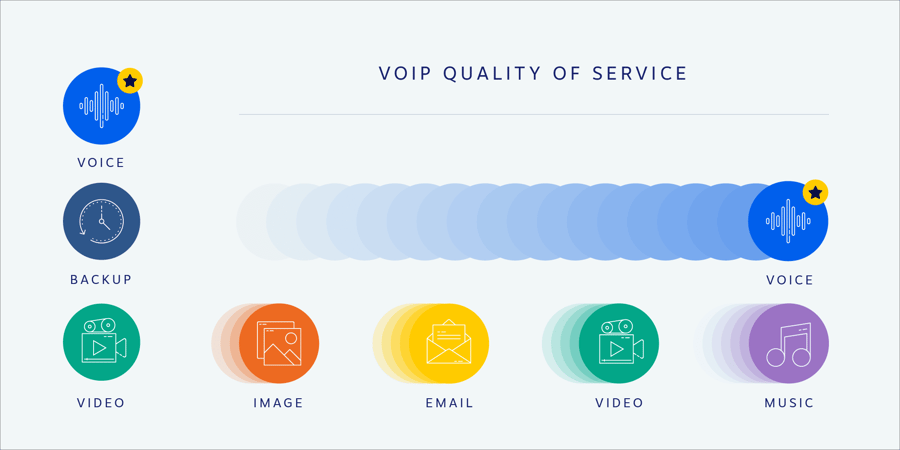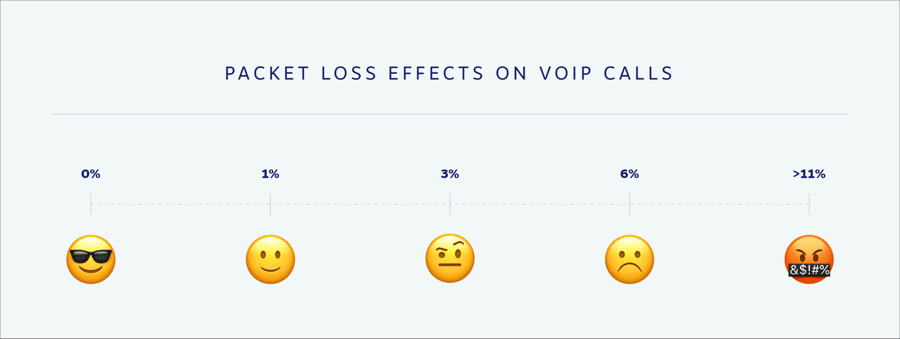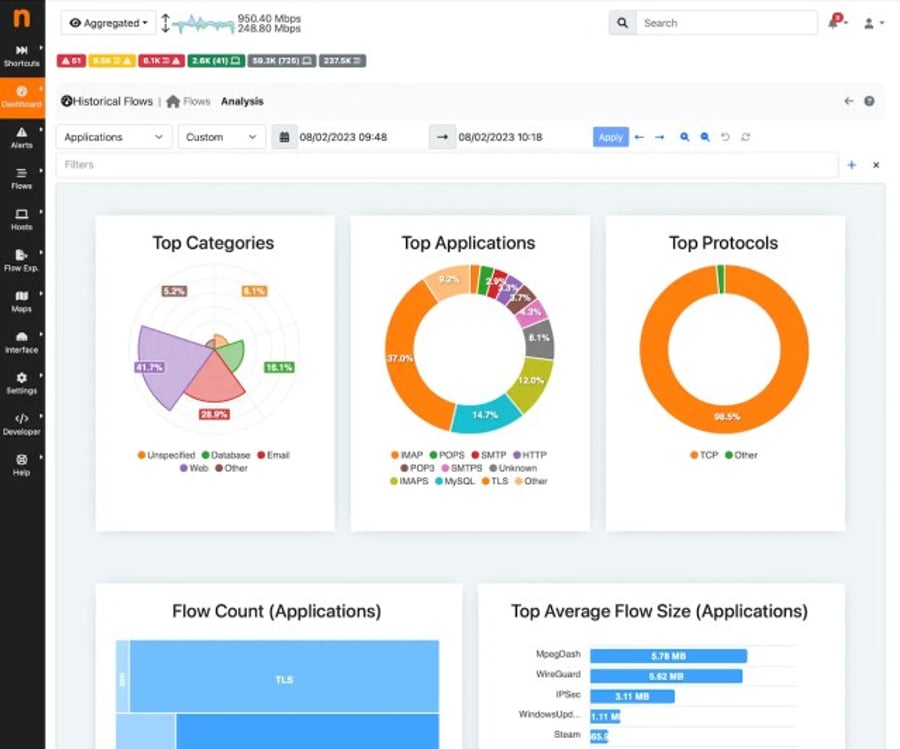Are you experiencing call quality issues when using VoIP? You’re not alone. People who use hosted phone services could experience voice quality issues no matter their internet connection speed.
Troubleshooting sound quality problems with VoIP calls can be challenging. Delays and unexpected silence threaten your credibility and cost you valuable business opportunities.
Quality of Service (QoS) network optimization can solve headaches that come with Voice over IP technology. Prioritizing voice traffic boosts the reliability and clarity of your phone calls.

We’ll walk you through understanding VoIP QoS, how to set it up, and tips to maintain superior call quality.
What Is VoIP Quality of Service?
Quality of Service (QoS) is a method to prioritize network traffic going through a router to provide acceptable service to most users. Administrators put QoS in place to address audio quality issues.
VoIP is susceptible to network congestion, resulting in echoes, lag, and dropped calls. VoIP relies on data packets arriving at their destination and in the correct order. High latency and jitter can cause glaring problems with Voice over IP phone calls.

Routers handle data packets by default following a First In First Out (FIFO) order. This can create queuing issues across your network when bandwidth use is high. QoS solves this by dedicating network resources based on the type of traffic and device.
Setting up QoS for IP telephony for the first time can be unfamiliar. Once done, you’ll enjoy better voice quality without adjusting the available bandwidth.
Here’s a quick video on how to solve common VoIP problems.

Why Does Quality of Service Matter?
A phone call with bad audio quality feels terrible. No matter the conversation, if it’s hard to hear, you’d do anything for the call to drop. Businesses have all kinds of conversations, such as:
- Sales demos and webinars
- Customer support
- Employee interviews
- Team meetings with business leaders
All these conversations are essential. But when customers perceive your calls as choppy or if they’re dropped, your online reputation suffers.
While we’ve all been annoyed by these issues, knowing how to fix them starts with learning how VoIP works. And that begins with reducing network congestion. Setting up QoS improves the call quality for everyone on your Local Area Network (LAN).

With the surge of remote work, people are using their home networks where business calls compete with the likes of YouTube, Netflix, Hulu, Disney+ … and regular data traffic demands in a household. This has made prioritizing VoIP traffic more important than ever.
And lastly, not all VoIP service providers are equal. It’s relatively cheap for companies to set up a VoIP system, but that doesn’t mean it’s reliable. This has resulted in different VoIP providers offering vastly different levels of reliability and call quality.
What minimum QoS does voice traffic need?
Cisco recommends these standards for better call quality than Public Switched Telephone Networks (PSTN).

The default G.729 codec requires packet loss of less than 1% to avoid audible errors. There should be no packet loss for VoIP.
The ITU G.114 specification recommends less than 150 ms one-way delay for real-time voice traffic.
Jitter buffers add to the end-to-end delay and are usually only effective on delay variations less than 100 ms. Jitter must be minimized.Cisco
No matter what VoIP phone service you use, you should implement QoS. Streaming media alongside operating system updates can affect call quality when you least expect it.
QoS isn’t a guarantee, but it’s the best way to tune your network for better voice over IP performance. Configuring QoS for VoIP only takes a few minutes on most routers.
Recommended VoIP QoS settings
It helps to familiarize yourself with a few common network benchmarks. Knowing these helps to troubleshoot VoIP and pinpoint the ideal solution.
- Latency measures the time it takes a packet of data to arrive at the destination IP address. All VoIP systems and all networks have some latency. Voice data packets are sensitive to delays exceeding 150 milliseconds each way.
- Network jitter measures the variation in packet delays, such as latency. When it comes to real-time voice, packets arrive out of order with an unstable network connection. As a result, VoIP calls become unintelligible. Network jitter above 30 ms will impact voice calls substantially.
- Packet loss measures the number of packets lost after transmission. Voice data packets are susceptible to any packet loss. Anything above 3% packet loss means the audio quality will become significantly reduced.
- LAN and WAN network topologies determine whether you can influence its endpoints. Local Area Network (LAN) refers to the network managed by your router. Wide Area Network (WAN) is the broader network on the internet. VoIP packets travel from your phones through your LAN and on the WAN to reach their destination.

All these factors contribute to the audio quality of VoIP calls. You don’t have to be an expert to set up VoIP QoS to improve call quality.
Adjusting VoIP Quality of Service settings
Every router and network configuration is unique. It doesn’t hurt to read up on the documentation provided by your network equipment vendor. Often, they have specific guides on implementing prioritization for voice traffic.
When setting up QoS for VoIP, you should consider the following approaches:
1) Prioritize network traffic by type, not device.
If you can prioritize network traffic by type, this is ideal. It ensures that devices can’t hog the available bandwidth. Instead, the nature of the traffic determines its queuing. A good fallback would be the bandwidth management for each networked device.
2) Assign traffic with a DSCP 46 with high priority.
Many VoIP devices advertise the classification of network traffic with a DSCP header. The Differentiated Services Code Point (DSCP) header tells network switches to honor high-priority packets. Configure both inbound and outbound RTP packets with DSCP 46 if you can.
3) If supported, set up Trust Mode with Strict Priority.
More sophisticated network switches and routers offer advanced queuing techniques. Trust mode allows switches to recognize the DSCP packets. Strict Priority ensures they aren’t weighted with other devices. Most routers have at least some form of VoIP QoS, so it’s okay if it’s not as advanced as this.
After you apply these VoIP QoS best practices and power-cycle your equipment, you should experience lower latency and more dedicated, consistent bandwidth during VoIP calls.
If you still experience issues, contact your business phone service to conduct further tests to isolate the cause. Continue reading for more solutions to resolving network QoS issues.
What VoIP QoS Can and Can’t Do
Diagnosing Voice over IP (VoIP) Quality of Service (QoS) Issues
While most users can diagnose VoIP QoS problems, fixing them can be challenging. Here’s a quick overview:
- VoIP voice packets pass through many network devices. Each device can affect call quality. If you have a complex setup with multiple routers and switches, depending on your network layout.
- Internet Service Providers (ISPs) control network throughput, impacting call quality during peak use. But QoS tweaks won’t improve ISP performance.
- Codecs compress audio to save bandwidth but can reduce sound quality and increase latency. Stable Internet is essential for quality VoIP calls.
- Prioritizing SIP traffic, disabling SIP ALG on routers, and fine-tuning QoS settings to favor voice packets. You might also want to prioritize network paths to known trusted VoIP carriers like Nextiva.
The network path for VoIP calls is complex. Work with your IT team to identify and solve quality issues. Focus on codecs, bandwidth, jitter, latency, and minimizing packet loss as the first places to improve call quality.
Best Practices for Better Call Quality
For most businesses, the first step is to select a reliable business VoIP provider. Trustworthy VoIP providers will be able to shed light on their VoIP network and tips to achieve optimal call quality.
- Use wired Ethernet connections. Wi-Fi is subject to interference, impairing phone calls at the worst possible time. Any Category 6 certified Ethernet cable offers low latency with gigabit duplexing. Plus, you eliminate the risk of a bad termination.
- Test your LAN and WAN connections regularly. Track metrics like ping, jitter, and bandwidth to detect network congestion. Voice over Internet Protocol uses 100 Kbps upload/download per line.
- Budget for 85% of your connection speed. Many businesses will reach the bandwidth limit offered by a DSL connection. Cable and fiber connections offer a lot more headroom. TCP and UDP connections have overhead that can fully utilize your bandwidth.
Popular QoS Monitoring Tools

Several popular Quality of Service (QoS) monitoring tools are available to network administrators. These tools help manage and improve network performance by ensuring mission-critical applications receive the necessary network priority.
Here are some well-known QoS monitoring tools:
- SolarWinds NetFlow Traffic Analyzer: SolarWinds offers a comprehensive tool that provides real-time visibility into network traffic flows. It analyzes NetFlow, IPFIX, and other flow technologies to monitor and troubleshoot network performance issues.
- Paessler PRTG Network Monitor: PRTG Network Monitor by Paessler is a powerful all-in-one monitoring solution that includes QoS monitoring capabilities. It enables administrators to monitor and manage network devices, bandwidth usage, and traffic flow to ensure optimal performance.
- Nagios Network Analyzer: Nagios Network Analyzer is a commercial-grade network monitoring solution that provides in-depth insights into network traffic and bandwidth utilization. It features advanced QoS monitoring capabilities to help administrators prioritize critical services and applications.
- ManageEngine NetFlow Analyzer: NetFlow Analyzer from ManageEngine is a comprehensive traffic analysis and monitoring tool. It leverages flow technologies to provide detailed visibility into network traffic and analyze QoS metrics to optimize network performance.
- OpenNMS: OpenNMS is an open-source network management platform that includes QoS monitoring capabilities. It offers features such as flow analysis, resource monitoring, and event notifications to ensure efficient network operation and troubleshooting.
- Ntopng: Ntopng is an open-source network traffic monitoring tool. It provides real-time traffic analysis and supports various flow protocols, allowing administrators to monitor and analyze QoS metrics for better network performance.
- BandwidthD: BandwidthD is an open-source bandwidth monitoring tool that can also be used for QoS monitoring. It tracks bandwidth usage by protocol and analyzes traffic trends to identify potential bottlenecks and prioritize critical applications.
These popular QoS monitoring tools offer a range of capabilities and features to help administrators effectively manage network performance and ensure optimal QoS for their critical applications and services.
Functions of QoS Network Tools
QoS network monitoring tools perform several functions to optimize network performance. Their top functions include:
- Classification: QoS tools can identify different types of traffic and assign them specific markings or labels.
- Queueing: QoS tools can reserve a portion of the available bandwidth to hold packets in a buffer for later processing.
- Policing: QoS tools enforce specific bandwidth limits and rules. If packets do not adhere to these rules, they are dropped. Policing is an essential part of congestion avoidance.
- Shaping: Similar to policing, QoS tools can queue excess traffic in a buffer instead of dropping them entirely.
- Fragmentation and Compression: QoS tools can employ techniques such as fragmentation and compression to reduce the required bandwidth on a network. By minimizing delay and jitter, these methods optimize network performance.
QoS tools may encompass any combination of these functions, allowing for a tailored approach to meet specific network requirements and efficiently utilize available resources.
Fixing QoS With Your VoIP Service Provider
Although you can improve your VoIP QoS, this doesn’t mean VoIP service providers offer the same service. Different providers offer different levels of availability.
Almost all our users never have any issues. Why? Our reliable business VoIP network withstands severe weather and heavy use. But when trouble strikes, we’re here to help you get the most from your VoIP service.
Most telephone companies won’t take the time to help you figure out the problem. They want to get you off the phone quickly. At Nextiva, it’s different. Everyone receives personalized support and can chat with knowledgeable technicians.
We pride ourselves on becoming the top virtual phone service ready to help you with your communication needs.
FAQs
Not all VoIP service providers offer the same level of reliability and call quality. While it may be relatively inexpensive for companies to set up an office phone system, the reliability can vary significantly. QoS can help address these differences by allowing routers to prioritize voice traffic alongside other network demands, ensuring a more consistent and reliable VoIP experience.
QoS network optimization is particularly important for VoIP technology. By prioritizing voice traffic, QoS helps to boost the reliability and clarity of phone calls, addressing issues such as inconsistent VoIP packets that can lead to gaps in brand trust and communication failures. This is especially critical now with the surge of remote work, where home networks compete with other data traffic demands.
QoS is crucial in improving user experience by ensuring real-time applications, such as VoIP phone calls or video conferencing, receive the necessary network resources. By prioritizing this traffic, QoS helps to minimize latency, reduce packet loss, and ensure smoother and clearer communication, resulting in an enhanced user experience.
Quality of Service (QoS) ensures that mission-critical applications have access to the necessary network resources they require. By prioritizing the traffic for these applications, QoS ensures that they receive the bandwidth and low latency they need for optimal performance and reliability.

















 VoIP
VoIP 







